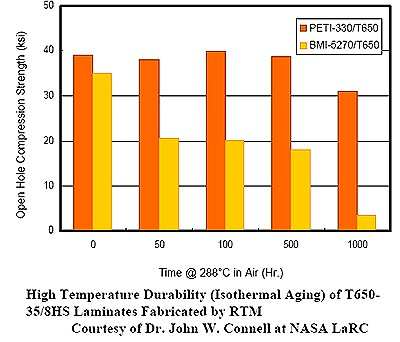Tue, Jul 20, 2004
New Generation High Performance Resin For Aerospace And
Commercial Applications
 UBE America and NASA have entered
into a license agreement for NASA's PETI-330. The announcement was
made by representatives of NASA, UBE America and UBE Industries
during the recent SAMPE meeting in Long Beach (CA).
UBE America and NASA have entered
into a license agreement for NASA's PETI-330. The announcement was
made by representatives of NASA, UBE America and UBE Industries
during the recent SAMPE meeting in Long Beach (CA).
PETI-330 was developed at NASA-Langley by a team headed by John
W. Connell and is covered by US Patent No. 6,359,107, "Composition
of and method for making high performance resins for infusion and
transfer molding processes." PETI-330 offers cost effective and
affordable fabrication of high temperature composite structures for
advanced aerospace vehicles. The unique combination of high
temperature performance and processing characteristics enables new
applications.
PETI-330 will be marketed and sold in North America by UBE
America under the license from NASA.
PETI-330 offers the following innovative characteristics:
- PETI-330 composites have excellent long-term (1,000 hours)
performance at 300�C.
PETI-330 provides an unprecedented combination of easy processing
for composite fabrication together with high temperature
performance and toughness.
- PETI-330 offers low (<10 Pa-s, 288�C) and stable melt
viscosity highly suited to RTM and other resin infusion
processes.
- There is a simple and efficient 1-hour full cure process with
no post-cure required.
- It has a high glass transition temperature 330�C /
626�F
- PETI-330 is both solvent free (no volatiles) and non toxic
- These characteristics provide the following benefits:
- Substantial improvements in both high and low temperature
performance compared with traditional materials such as epoxies or
bismaleimides.
- Superior combination of processability and mechanical
properties compared with existing polyimides such as PMR-15
- A simplified cure process which makes it highly suitable for
mass production requirements
- A reduced fabrication time for components and assemblies
- Reduced mass & weight for high temperature structural
applications (i.e. it can replace metallic parts and
assemblies)
- A more cost effective alternative to complex part
assembly

A spokesman for UBE stated, "UBE Industries will fully support
the efforts of UBE America to develop and expand the market for
this revolutionary resin. UBE continues its research and
development work on new resins for aerospace applications."
"The first market to benefit from this new technology will be
the aerospace industry, particularly the military sector. PETI-330
will replace metal parts of the aircraft, including helicopters,
which will considerably decrease their weight," said Kei Tsukahara,
product manager, UBE America.
"We expect a great demand for this exciting new product. UBE
America is currently working on creating an inventory of samples
for potential customers," said Tsukahara.
UBE Industries has a patent on additional types of polyimide
using a-BPDA in the United States. It is currently filing for
patents in Europe and Japan.
PETI-330 complements the existing portfolio of products offered by
UBE for the aerospace industry, including UPILEX Polyimide Film and
TYRANNO Silicon Carbide Fiber.
More News
Aero Linx: International Federation of Airworthiness (IFA) We aim to be the most internationally respected independent authority on the subject of Airworthiness. IFA uniquely combi>[...]
Ultrahigh Frequency (UHF) The frequency band between 300 and 3,000 MHz. The bank of radio frequencies used for military air/ground voice communications. In some instances this may >[...]
A Few Questions AND Answers To Help You Get MORE Out of ANN! 1) I forgot my password. How do I find it? 1) Easy... click here and give us your e-mail address--we'll send it to you >[...]
From 2019 (YouTube Edition): Learning To Paint Without Getting Any On Your Hands PPG's Aerospace Coatings Academy is a tool designed to teach everything one needs to know about all>[...]
Also: Sustainable Aircraft Test Put Aside, More Falcon 9 Ops, Wyoming ANG Rescue, Oreo Cookie Into Orbit Joby Aviation has reason to celebrate, recently completing its first full t>[...]
 ANN's Daily Aero-Linx (05.06.25)
ANN's Daily Aero-Linx (05.06.25) ANN's Daily Aero-Term (05.06.25): Ultrahigh Frequency (UHF)
ANN's Daily Aero-Term (05.06.25): Ultrahigh Frequency (UHF) ANN FAQ: Q&A 101
ANN FAQ: Q&A 101 Classic Aero-TV: Virtual Reality Painting--PPG Leverages Technology for Training
Classic Aero-TV: Virtual Reality Painting--PPG Leverages Technology for Training Airborne 05.02.25: Joby Crewed Milestone, Diamond Club, Canadian Pilot Insurance
Airborne 05.02.25: Joby Crewed Milestone, Diamond Club, Canadian Pilot Insurance



